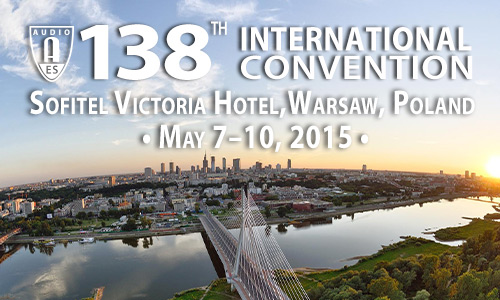
AES Warsaw 2015
Paper Session P5
P5 - (Lecture) Audio Signal Processing
Friday, May 8, 09:00 — 11:00 (Room: Belweder)
Chair:
Christoph M. Musialik, Sennheiser Audio Labs - Waldshut-Tiengen, Germany
P5-1 Multi-Rate System for Arbitrary Audio Processing—Daekyoung Noh, DTS, Inc. - Santa Ana, CA, USA
An efficient multi-rate system for arbitrary audio processing is proposed. In order to minimize computational complexity, high sampling rate signals are decimated and split into two subbands. The process can be repeated in the low band to obtain a maximally decimated system. Then, only the lowest band is being processed with arbitrary audio processing. Amplitude and group delay compensation are performed to the rest of the bands to minimize aliasing noise and amplitude distortion that can be caused when the bands are recombined due to arbitrary audio processing performed in the low bands. The Goertzel algorithm transition band addition/subtraction method is introduced for group delay correction in real-time processing. Once arbitrary processing is done in the lowest band the subbands are then up-sampled and recombined. Finally, test results and computational advantages are discussed.
Convention Paper 9252 (Purchase now)
P5-2 A Short-Term Analysis of a Digital Sigma-Delta Modulator with Nonstationary Audio Signals—Marcin Lewandowski, Warsaw University of Technology - Warsaw, Poland
Signal conversion quality of sigma-delta (S?) digital-to-analog audio converters (DACs) mainly depends on the S? modulator's parameters. Conventional quality examination of S? audio DACs has been performed in the frequency domain and can be considered indicative of quality only in the case of linear and stationary systems. However, highly nonlinear and nonstationary S? modulators create errors that depend on the input signal. In this study, a method for evaluating S? modulators in the time-domain is presented. Simulations and analysis were performed with the use of music signals. Results showed that the short-term performance of digital S? modulators is highly correlated with the variation of the input signal. This is particularly important as S? modulators are commonly used in DACs of both consumer and professional audio equipment.
Convention Paper 9253 (Purchase now)
P5-3 Application of Sinusoidal Coding for Enhanced Bandwidth Extension in MPEG-H USAC—Tomasz Zernicki, Zylia sp. z o.o. - Poznan, Poland; Maciej Bartkowiak, Poznan University of Technology - Poznan, Poland; Lukasz Januszkiewicz, Zylia sp. z.o.o. - Poznan, Poland; Marcin Chryszczanowicz, Zylia sp. z.o.o. - Poznan, Poland
A new audio coding technique applicable to very low bit rates is proposed. The existing MPEG-D standard of Unified Speech and Audio Coding (USAC) is enhanced by a new High Frequency Sinusoidal Coder (HFSC), employed for improving the subjective quality of high frequency spectral content. The paper gives an overview of the new technique as well as it offers some insight into the operation modes and delay issues. A statistically evidenced significant improvement of the audio quality resulting from applying this technique is demonstrated.
Convention Paper 9254 (Purchase now)
P5-4 Practical Considerations of Time-Varying Feedback Delay Networks—Sebastian J. Schlecht, International Audio Laboratories - Erlangen, Germany; Emanuël A. P. Habets, International Audio Laboratories Erlangen - Erlangen, Germany
Feedback delay networks (FDNs) can be efficiently used to generate parametric artificial reverberation. Recently, the authors proposed a novel approach to time-varying FDNs by introducing a time-varying feedback matrix. The formulation of the time-varying feedback matrix was given in the complex eigenvalue domain, whereas this contribution specifies the requirements for real valued time-domain processing. In addition, the computational costs of different time-varying feedback matrices, which depend on the matrix type and modulation function, are discussed. In a performance evaluation, the proposed orthogonal matrix modulation is compared to a direct interpolation of the matrix entries.
Convention Paper 9255 (Purchase now)
